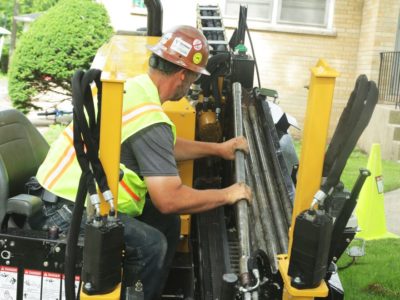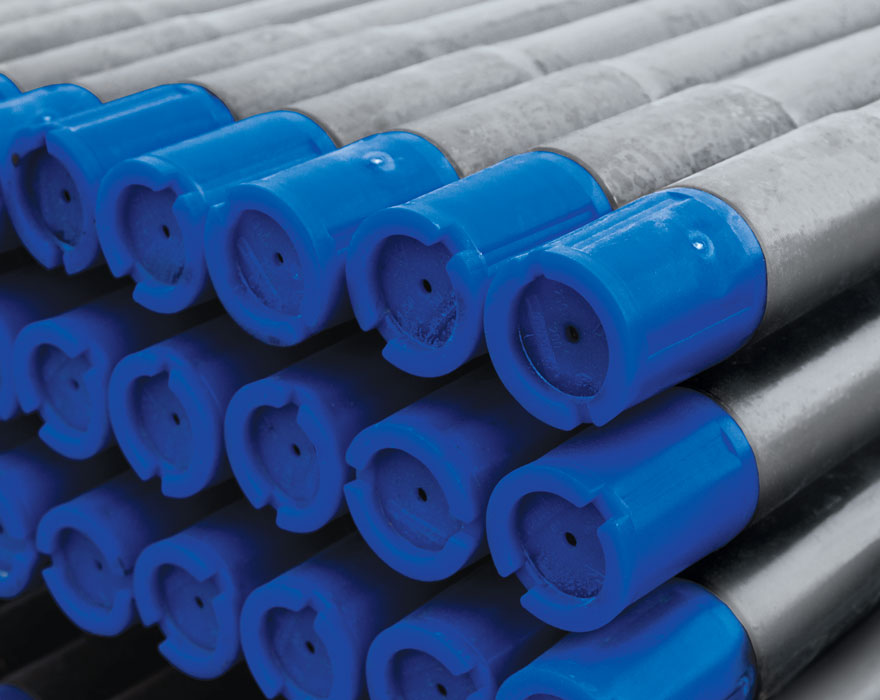One of the complications with horizontal directional drilling is recognizing when it’s the right time to replace or rotate your drill rod. When do you do it? It can be tempting to maximize the life out of them, but doing that can lead to the other rods being affected. Instead, knowing the signs of worn-down drill rod can save you time and effort.
Here are several indicators of how to know when it’s time to replace or rotate your drill rod, tips on how to maintain them well, and why they’re important to the overall health of your drill and jobsite. Refer to your machine’s operator’s and maintenance manual for safety messages and further instructions.
Rotation tips
Here are some valuable tips when it comes to rotating your drill rod:
- Once a week, you want to take off your lead rod (the first rod behind the drill head or starter rod) and put it in the back of the rack, so you’re rotating it
- Why? That first rod takes a lot more stress than the rest of the string behind the drill head, so it’s wearing faster than the other rod behind it
- Once you put the lead rod in the back, put a fresh rod on and drill with that
- Why? If you have that built into your process, you’ll cycle all that rod through the process of being a lead rod, getting more ease and wear out of the entire basket
“If you’re rotating that lead rod, it’s like rotating the tires on your car,” said Cody Mecham, Vermeer cutting edge product manager. “That whole rack of pipe should be worn out at the same time. If you don’t, one or two rods will reach end of life significantly faster.”
Rod inspection tips
Another habit you’ll want to consider is periodically inspecting your rod connections. Here are some tips on what to look for:
- First, look at the pin end, and make sure the threads are in good shape
- Note: If you’re getting dirt and contaminates, remove those with a cleaner
- Then look at the nose and make sure it’s not mushroomed
- If it’s mushroomed, that would indicate you may not be achieving proper makeup torque
- Why that matters: If under torqued, the thread will be stressed and become over torqued once down hole. When this happens, it can mushroom the pin end of the rod and could lead to flaring and galling.
- Make sure you’re achieving full makeup torque
- Make sure the threads aren’t sharp or rolled back, and at the pin end of the rod look and check for mushrooming
- This is an indicator of under torqued pipe,
- Look for flaring in the box end, and if it’s starting to widen out
- This can indicate the drill rod is close to the end of its life
- Make sure your upsets are in good shape (these are right behind the pin and box end)
- Make sure there aren’t any gouges or damage from hitting rocks downhole
- Check for fluid leakage at the joint
- Leaking drill rod joints indicate damaged shoulders, which will not torque correctly
- Check shoulders for dents, gouges or high posts
- Dress damaged shoulders with a file
Machine alignment tips
One way to maximize the life of your drill rod is to make sure your machine is aligned correctly. This is critical if you’re operating any Vermeer drill above a Vermeer D10x15 horizontal directional drill (HDD) with a rod loader. The rod loader arms are adjustable and have wear pads, so make sure these are adjusted accordingly.
“Sometimes a rod will be off just a touch, and that misalignment can wear down the pins, box ends and threads, so checking alignment is critical,” said Mecham.
To check alignment, present a rod with the loader arms fully extended and look at the alignment of the sub saver/drive chuck with the rod. Then check the alignment of the front of the rod with the vices. Rod life can also be maximized utilizing the float on the drill, located on the gearbox. Cylinders allow that gearbox to float back and forward. The float equals the distance it takes to make a rod up and breakout front and back.
“When you’re making up a rod, it’s floating, so you don’t have pressure on that pin,” explained Mecham. “The carriage should be forward a touch, so as you makeup the thread it will pull the carriage down. Then, as you break up, the gear box can float up and not put pressure on the drill pipe.”
Sub saver tips
The components of the drill that stay above ground and come into contact with the rod should be closely monitored for wear or damage. Along with the upset and the threads, the sub saver should also be monitored frequently. Refer to the drill’s operator’s and maintenance manuals for the further instruction.
Sub savers are manufactured to handle the tolerance of HDD rigs. Much like the drill rods, sub savers feature specifically machined threads that are meant to create a strong tool joint with each rod placed on the rack.
“When you notice wear on the thread, make sure that you put on fresh sub savers,” said Mecham. “You can use a thread gauge to check the quality of your sub savers, but it’s not required. The thread gauge teeth engage with the sub saver thread teeth, and if you can see through it, then it’s time to change your sub savers.”
Vise die tips
Another area to watch is your vise dies to check that they’re in good shape.
- How often: Clean them out once a week
- What to do: Make sure you get the grease out and remove any dirt or rock. This helps maximize die life and pipe life, so it won’t create an issue or slip during makeup
One more tip about vise dies: If you break pipe out and your vises are slipping on the pipe, even after you put on new vise dies, it’s likely that the pipe’s upsets are worn down past their useful life. When this happens, the vise can’t properly grip the upsets.
“An upset gauge can help you determine the life of your upsets,” explained Mecham. “Slide it over the upsets of the box and pin end, and if the gauge will go up over the upset, then it’s worn down too much.”
If your rod won’t break out anymore, it’s very likely your upsets have significant wear or you have deformation of its threads.
Bent rod tips
If you ever experience a bent rod, it should be replaced immediately. When you’re threading pipe up, it’s usually very evident that the rod is bent.
“Usually a bent rod won’t line up on the drill correctly, and should be taken out of the drill string immediately,” said Mecham. “It’s likely been oversteered. Pipe has memory, and steers are cumulative. So, if you oversteer it today, it might not bend until two weeks later from the memory of that oversteer.”
Dual rod tips
For those that use dual rod, there are things you can do to check its condition.
Inspect the inner rod and make sure there’s no galling or cracking in those connections. Then, take a look at the couplers and flow rings.
“The flow rings allow fluid to pass through them and, because they ride on that inner rod, they can wear quickly,” explained Mecham. “You don’t want to go downhole with a worn-down flow ring. But they’re convenient to replace.”
Your drill rod are an essential part of operating your drill, and properly maintaining them can help maximize their life and keep you drilling with minimal interruption. For more information or questions, reach out to your local Vermeer dealer.
Always refer to the product’s operator’s and/or maintenance manual for safety messages and further instructions.
Vermeer Corporation reserves the right to make changes in engineering, design and specifications; add improvements; or discontinue manufacturing at any time without notice or obligation. Equipment shown is for illustrative purposes only and may display optional accessories or components specific to their global region. Please contact your local Vermeer dealer for more information on machine specifications and attachments.
Vermeer and the Vermeer logo are trademarks of Vermeer Manufacturing Company in the U.S. and/or other countries. © 2022 Vermeer Corporation. All Rights Reserved.

